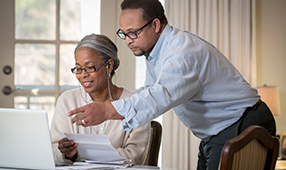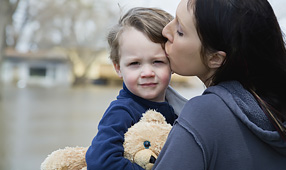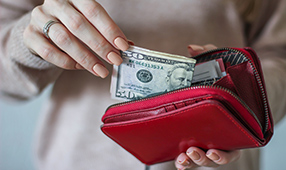As the school year approaches, you review your curriculum and figure out if you have the right instructional game plan in place.
So why not do the same with your personal finances? To get started working on your financial game plan, ask yourself these four important questions.
1. Do I have (or have enough in) an emergency fund?
Inevitably, something will go wrong that catches you by surprise—and costs plenty. Your car may need a new set of tires. Your home water heater could go on the fritz. You might end up paying a pricey deductible due to an unexpected hospital visit. (And if you have kids, you should at least double the “Wow! Didn’t see that coming …” factor.)
Given life’s unpredictability, experts recommend that every household set aside funds to cover any and all rainy-day situations. So how much is enough?
The traditional rule of thumb is three to six months’ worth of living expenses. Such a goal can sound intimidating, but you are far from alone, as one-quarter of Americans have no emergency savings, and two-thirds do not have six months of expenses set aside.
Yet, it’s critical to get started. So set a realistic beginner’s goal: Save enough to cover one month of expenses. “Bad things will happen and you need to prepare,” says Danny Kofke, author of “How to Survive (and Perhaps Thrive) on a Teacher’s Salary.” “If you can save one week’s worth in a month, then you do it for four months and—voila!—you have a starter emergency fund. If the money isn’t sitting around, how do you get it? Perhaps by selling some items you no longer use from your home. Or working in an after-school program during the year. Do whatever it takes.”
Put the money in a vehicle that you can access immediately, such as a bank savings account. “Don’t worry about the interest rate, either,” says Kofke. “You want an account that won’t tempt you to dip into it for non-emergencies, but you won’t pay a penalty for accessing it.” After you’ve saved enough for one month of living expenses, then work toward two months, then three, then four, until you reach the important six-month milestone.
2. Will I be ok if I’m unable to work?
No one plans to become ill or injured to the point of being unable to work, but it does happen. It’s important to protect yourself in case you do become disabled and can no longer perform your duties. No work can mean no paycheck.
Essentially, you have two choices: Short- and long-term disability insurance. Both typically pay about 60% of your salary during the time that you’re out (after you’ve exhausted sick leave). Short-term pays for a certain, limited period (perhaps three months or up to a year), and long-term kicks in after that. Short term payments generally begin within a two-week period. Long-term payments usually start after 90 days.
“One of the great things about disability insurance is cost,” Kofke says. “When I was teaching, I only paid $10 a month for long-term. Even if it wouldn’t have replaced 100% of my income, it was nice to know I had something coming if I was not able to work.”
3. Do I have the right auto and/or home insurance?
It’s important to match your vehicle to the right auto insurance policy. You may not need collision insurance on an old car, for example, if you have enough money set aside to replace it’s totaled in an accident. However, if your vehicle is new or you don’t have the money set aside to replace it, then buy enough protection to match its value. There’s no point, after all, in buying more than you need.
Next, you want to whittle down the price of your premiums. “One way—especially for safe drivers who are less likely to get into accidents—is to raise your deductible to $500 or $1,000,” says personal finance expert Debbi King, author of “The ABC’s of Personal Finance.” “You should raise it only to the limit that you can afford. You can also lower payments by raising your credit score. Because it reflects upon your sense of responsibility, the higher your score, the better the rate you’ll earn. Also, take advantage of cash discounts—you’ll save a ton by paying in full in the beginning of a policy cycle.”
Homeowners and renters insurance are must have policies as well. If you’re renting, the landlord is strictly responsible for the structure of the residence/unit. “Therefore, you need to account for all of your possessions in there in case of theft or damage,” King says. “The good news: You can buy $10,000 in coverage for as little as $9 a month.”
Approach homeowners insurance as you would for your vehicle: If you can afford a higher deductible—by keeping enough money in an emergency fund to cover repairs—you’ll lower the cost of the policy. “Again, a strong credit score and cash payments will further reduce the price,” King says. “And don’t make a claim for everything that’s eligible, to avoid high premiums.”
4. Can I manage my paycheck better?
If you don’t have a traditional checking account, you might want to consider a prepaid debit (or purchase) card to help with budgeting and paying bills. It can protect you from spending beyond your budget limits—you only use what you’ve already paid for in advance.
“This is a better alternative to cash for someone without a bank account,” says Kari Luckett, who runs the CompareCards blog. “If someone steals your cash, you’re not likely to get it back. But if someone steals your prepaid debit card, you can alert the financial institution that issued the card and even get your money back, if the card comes with fraud protection.”
And if you arrange to have your paycheck directly deposited to your card, you could receive your funds up to two days faster than with a paper check—plus, no waiting in line to cash it.
Ready for more? Before the new school year gets into full swing, review and update this critical information to help protect yourself and your family.












